 ® ® |
Pacific Beach
- Home |

|
Surf's up in PB
|

South
Coast Windansea Surf
740 Felspar Street # A, San Diego, CA 92109
(858) 483-7660
Pacific Beach Surf Shop
747 Pacific Beach Drive, San Diego, CA 92109
(858) 488-9575
Hank Warner Custom Shapes
705 Felspar Street, San Diego, CA 92109
(858) 270-1829
Joe Roper's Surfboard Repair
740 Felspar Street, San Diego, CA 92109
(858) 274-3464
Skip Frye Surfboards
705 Felspar Street, San Diego, CA 92109
(858) 270-3886
Star Surfing Company
4652 Mission Boulevard, San Diego, CA 92109
(858) 273-7827
Solid Surf
4655 Mission Boulevard, San Diego, CA 92109
(858) 273-7873
Surf Club
952 Garnet Avenue, San Diego, CA 92109
(858) 483-4854
Bob's Mission Surf
4320 Mission Boulevard, San Diego, CA 92109
(858) 483-8837
Pacific Drive Skateboard Shop
756 Thomas Avenue, San Diego, CA 92109
(858) 270-3361
Play It Again Sports
1401 Garnet Avenue, San Diego, CA 92109
(858) 490-0222
Wind an Sea Surf Boards
3780 Mission Boulevard, San Diego, CA 92109
(858) 488-9374
Liquid Foundation Surfboards
3731 Mission Boulevard, San Diego, CA 92109
(858) 488-3260
El Nino Clothing Company
5648 LA Jolla Boulevard, La Jolla, CA 92037
(858) 456-6466
Mother
5680 LA Jolla Boulevard, La Jolla, CA 92037
(858) 456-5244
Gone Bananas Beachwear
3785 Mission Boulevard, San Diego, CA 92109
(858) 488-4900
Pilar's Beach Wear
3745 Mission Boulevard, San Diego, CA 92109
(858) 488-3056
Paradise Cove
4500 Ocean Boulevard, San Diego, CA 92109
(858) 272-1407
Camille's of PB
4666 Mission Boulevard, San Diego, CA 92109
(858) 272-1927
Ivory Coast Safari Club
4150 Mission Boulevard # 149, San Diego, CA 92109
(858) 581-6888
Sussy's Enterprises
3792 Mission Boulevard # R1, San Diego, CA 92109
(858) 488-8918
Anana's
714 Garnet Avenue, San Diego, CA 92109
(858) 274-4006
Rebel X Sports
810 Emerald Street, San Diego, CA 92109
(858) 581-6147
Sea Trader
4500 Ocean Boulevard, San Diego, CA 92109
(858) 692-4146
|

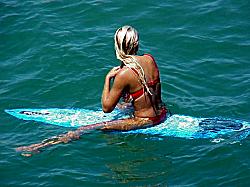
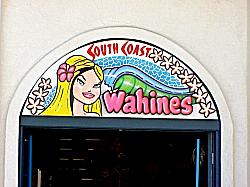
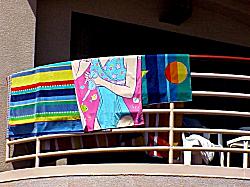
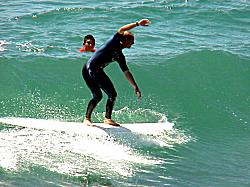
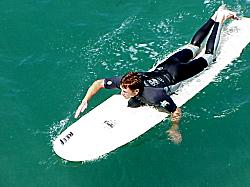
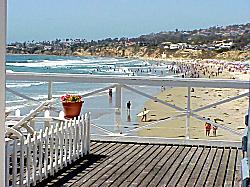
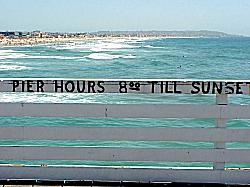
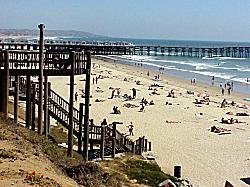
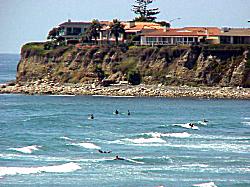
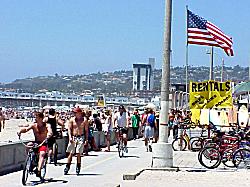 |
From here, check out the Surf
Shops,
places to Hang out, spend the night.....
Return to
Pacific Beach Home Page
Return to GoThere/San
Diego
to
link
Wiki
Surfing is a surface water sport
in which the participant is carried by a breaking wave on a surfboard. There are
various kinds of surfing, based on the different methods or surf craft used to
ride a wave. The basic categories include regular stand-up surfing, kneeboarding,
bodyboarding, surf-skiing, bodysurfing, windsurfing, and kite surfing. Further
sub-divisions reflect differences in surfboard design, such as long-boards and
short-boards. Tow-in surfing involves motorized craft to tow the surfer onto the
wave. It is associated with surfing huge waves, which are extremely difficult to
ride and sometimes impossible to catch by paddling down the face, due to their
rapid forward motion.
Surfers and Surf Culture
Surfers represent a diverse culture based on riding the naturally occurring
process of ocean waves. Some people practice surfing as a recreational activity
while others demonstrate extreme devotion to the sport by making it the central
focus of their lives.
The sport has become so popular that surfing now represents a multi-billion
dollar industry. Some people make a career out of surfing by receiving corporate
sponsorships, competing in contests, or marketing and selling surf related
products, such as equipment and clothing. Other surfers separate themselves from
any and all commercialism associated with surfing. These soul surfers, as they
are often called, practice the sport purely for personal enjoyment and many even
find a deeper meaning through involving themselves directly with naturally
occurring wave patterns and subscribe to ecocentric philosophies, or ecosophies.
The Science of Surfing Waves
Several factors influence the shape and quality of breaking waves. These include
the bathymetry of the surf break, the direction and size of the swell, the
direction and strength of the wind and the ebb and flow of the tide.
Swell is generated when wind blows consistently over a large area of open water,
called the wind's fetch. The size of a swell is determined by the strength of
the wind, the length of its fetch and its duration. So, surf tends to be larger
and more prevalent on coastlines exposed to large expanses of ocean traversed by
intense low pressure systems.
Local wind conditions affect wave quality, since the rideable surface of a wave
can become choppy in blustery conditions. Ideal surf conditions include a light
to moderate strength "offshore" wind, since this blows into the front of the
wave.
The factor which most determines wave shape is the topography of the seabed
directly behind and immediately beneath the breaking wave. The contours of the
reef or sand bank influence wave shape in two respects. Firstly, the steepness
of the incline is proportional to the resulting upthrust. When a swell passes
over a sudden steep slope, the force of the upthrust causes the top of the wave
to be thrown forward, forming a curtain of water which plunges to the wave
trough below. Secondly, the alignment of the contours relative to the swell
direction determines the duration of the breaking process. When a swell runs
along a slope, it continues to peel for as long as that configuration lasts.
When swell wraps into a bay or around an island, the breaking wave gradually
diminishes in size, as the wave front becomes stretched by diffraction. For
specific surf spots, the state of the ocean tide can play a significant role in
the quality of waves or hazards of surfing there. Tidal variations vary greatly
among the various global surfing regions, and the effect the tide has on
specific spots can vary greatly among the spots within each area. Locations such
as Bali, Panama, and Ireland experience 2-3 meter tide fluctuations, whereas in
Hawaii the difference between high and low tide is typically less than one
meter.
In order to know a surf break, one must be sensitive to each of these factors.
Each break is different, since the underwater topography of one place is unlike
any other. At beach breaks, even the sandbanks change shape from week to week,
so it takes commitment to get good waves (a skill dubbed "broceanography" by
California surfers). That's why surfers have traditionally regarded surfing to
be more of a lifestyle than a sport. Of course, you can sometimes be lucky and
just turn up when the surf is pumping. But, it is more likely that you will be
greeted with the dreaded: "You should have been here yesterday." Nowadays,
however, surf forecasting is aided by advances in information technology,
whereby mathematical modeling graphically depicts the size and direction of
swells moving around the globe.
The regularity of swell varies across the globe and throughout the year. During
winter, heavy swells are generated in the mid-latitudes, when the north and
south polar fronts shift toward the Equator. The predominantly westerly winds
generate swells that advance eastward. So, waves tend to be largest on west
coasts during the winter months. However, an endless train of mid-latitude
cyclones causes the isobars to become undulated, redirecting swells at regular
intervals toward the tropics.
East coasts also receive heavy winter swells when low pressure cells form in the
sub-tropics, where their movement is inhibited by slow moving highs. These lows
produce a shorter fetch than polar fronts, however they can still generate heavy
swells, since their slower movement increases the duration of a particular wind
direction. After all, the variables of fetch and duration both influence how
long the wind acts over a wave as it travels, since a wave reaching the end of a
fetch is effectively the same as the wind dying off.
During summer, heavy swells are generated when cyclones form in the tropics.
Tropical cyclones form over warm seas, so their occurrence is influenced by El
Ni�o & La Ni�a cycles. Their movements are unpredictable. They can even move
westward, which is unique for a large scale weather system. In 1979, Tropical
Cyclone Kerry wandered for 3 weeks across the Coral Sea and into Queensland,
before dissipating.
The quest for perfect surf has given rise to a field of tourism based on the
surfing adventure. Yacht charters and surf camps offer surfers access to the
high quality surf found in remote, tropical locations, where trade winds ensure
offshore conditions. Since winter swells are generated by mid-latitude cyclones,
their regularity coincides with the passage of these lows. So, the swells arrive
in pulses, each lasting for a couple of days, with a couple of days between each
swell. Since bigger waves break in a different configuration, a rising swell is
yet another variable to consider when assessing how to approach a break.
Artificial Reefs
The value of good surf has even prompted the construction of artificial reefs
and sand bars to attract surf tourism. Of course, there is always the risk that
one's holiday coincides with a "flat spell". Wave pools aim to solve that
problem, by controlling all the elements that go into creating perfect surf,
however there are only a handful of wave pools that can simulate good surfing
waves, owing primarily to construction and operation costs and potential
liability.
Wave intensity classification
The geometry of tube shape can be represented as a ratio between length and
width. A perfectly cylindrical vortex has a ratio of 1:1, while the classic
almond-shaped tube is nearer 3:1. When width exceeds length, the tube is
described as "square". Surf breaks can be grouped according to their intensity.
There are two variables to consider in determining the intensity of a surf
break: the shape of the tube and the angle of the peel line. Tube shape
indicates the degree of up thrust, which is roughly proportional to the volume
of water being thrown over with the lip. The angle of the peel line reflects the
speed of the tube. A fast, "down the line" tube has a peel line with a smaller
angle than a slower, "bowly" tube.
Classification parameters
Tube shape defined by length to width ratio
Square: <1:1
Round: 1-2:1
Almond: >2:1
Tube speed defined by angle of peel line
Fast: 30�
Medium: 45�
Slow: 60�
Wave intensity table Fast Medium Slow
Square The Cobra Teahupoo Shark Island
Round Speedies, Gnaraloo Banzai Pipeline
Almond Lagundri Bay, Superbank Jeffreys Bay, Bells Beach Angourie Point
Surfing maneuvers
Surfing begins with the surfer eyeing a rideable wave on the horizon and then
matching its speed (by paddling or sometimes, in huge waves, by tow-in). A
common problem for beginners is not even being able to catch the wave in the
first place, and one sign of a good surfer is being able to catch a difficult
wave that other surfers cannot.
Once the wave has started to carry the surfer forward, the surfer quickly jumps
to his or her feet and proceeds to ride down the face of the wave, generally
staying just ahead of the breaking part (white water) of the wave (in a place
often referred to as "the pocket" or "the curl"). This is a difficult process in
total, where often everything happens nearly simultaneously, making it hard for
the uninitiated to follow the steps.
Surfers' skills are tested not only in their ability to control their board in
challenging conditions and/or catch and ride challenging waves, but also by
their ability to execute various maneuvers such as turning and carving. Some of
the common turns have become recognizable tricks such as the "cutback" (turning
back toward the breaking part of the wave), the "floater" (riding on the top of
the breaking curl of the wave), and "off the lip" (banking off the top of the
wave). A newer addition to surfing has been the progression of the "air" where a
surfer is able to propel oneself off the wave and re-enter.
"Tube riding" is when a surfer maneuvers into a position where the wave curls
over the top of him or her, forming a "tube" (or "barrel"), with the rider
inside the hollow cylindrical portion of the wave. This difficult and sometimes
dangerous procedure is arguably the most coveted and sought after goal in
surfing.
"Hanging Ten" and "Hanging Five" are moves usually specific to longboarding.
Hanging Ten refers to having both feet on the front end of the board with all
ten of the surfer's toes off the edge, also known as noseriding. Hanging Five is
having just one foot near the front, and five toes off the edge.
Common Terms:
Regular foot - Right foot on back of board
Goofy foot - Left foot on back of board
Take off - the start of a ride
Drop in - dropping into (engaging) the wave, most often as part of standing up
Drop in on (or "cut off") - taking off on a wave in front of someone else
(considered inappropriate)
Duck dive - pushing the board underwater, nose first, and diving through an
oncoming wave instead of riding it
Snaking - paddling around someone to get into the best position for a wave (in
essence, stealing it)
Bottom turn - the first turn at the bottom of the wave
Shoulder - the unbroken part of the wave
Cutback - a turn cutting back toward the breaking part of the wave
Fade - on take off, aiming toward the breaking part of the wave, before turning
sharply and surfing in the direction the wave is breaking towards
Over the falls - out of control, going over the front of the wave and wiping out
Pump - an up/down carving movement that generates speed along a wave
Stall - slowing down from weight on the tail of the board or a hand in the water
Floater - riding up on the top of the breaking part of the wave
Hang-five/hang-ten - putting five or ten toes respectively over the nose of a
longboard
Re-entry - hitting the lip vertically and re-rentering the wave in quick
succession.
Switch-foot - having equal ability to surf regular foot or goofy foot -- like
being ambidextrous
Tube riding - riding inside the curl of a wave
Carve - turns (often accentuated)
Off the Top - a turn on the top of a wave, either sharp or carving
Snap - a quick, sharp turn off the top of a wave
Fins-free snap - a sharp turn where the fins slide off the top of the wave
Air/Aerial - riding the board briefly into the air above the wave, landing back
upon the wave, and continuing to ride.
Surfing equipment
Surfing can be done on various pieces of equipment, including surfboards,
bodyboards, wave skis, kneeboards and surf mat. Surfboards were originally made
of solid wood and were generally quite large and heavy (often up to 12 feet long
and 100 pounds / 45 kg). Lighter balsa wood surfboards (first made in the late
1940s and early 1950s) were a significant improvement, not only in portability,
but also in increasing maneuverability on the wave.
Most modern surfboards are made of polyurethane foam (with one or more wooden
strips or "stringers"), fiberglass cloth, and polyester resin. An emerging surf
technology is an epoxy surfboard, which are stronger and lighter than
traditional fiberglass.
Equipment used in surfing includes a leash (to keep a surfer's board from
washing to shore after a "wipeout", and to prevent it from hitting other
surfers), surf wax and/or traction pads (to keep a surfers feet from slipping
off the deck of the board), and "fins" (also known as "skegs") which can either
be permanently attached ("glassed-on") or interchangeable. In warmer climates
swimsuits, surf trunks or boardshorts are worn, and occasionally rash guards; in
cold water surfers can opt to wear wetsuits, boots, hoods, and gloves to protect
them against lower water temperatures.
There are many different surfboard sizes, shapes, and designs in use today.
Modern longboards, generally 9 to 10 feet in length, are reminiscent of the
earliest surfboards, but now benefit from all the modern innovations of
surfboard shaping and fin design.
The modern shortboard began its life in the late 1960s evolving up to today's
common "thruster" style shortboard, a three fin design, usually around 6 to 7
feet in length.
Midsize boards, often called funboards, provide more maneuverability than a
longboard, with more floatation than a shortboard. While many surfers find that
funboards live up to their name, providing the best of both surfing modes,
others are critical. "It is the happy medium of mediocrity," writes Steven
Kotler. "Funboard riders either have nothing left to prove or lack the skills to
prove anything."
There are also various niche styles, such as the "Egg", a longboard-style short
board, the "Fish", a short and wide board with a split tail and two or four
fins, and the "Gun", a long and pointed board specifically designed for big
waves.
Surfing dangers
Surfing, like all water sports, has the obvious inherent danger of drowning,
however this danger can be higher than in other water sports. When surfing, a
surfer should not assume that they will always have their board to keep them
buoyant - the leg rope could break or fall off some other way, and the board
could become separated from the surfer by unpredictable wave crashes. A surfer
needs to be confident that he/she can safely swim back to the beach unaided
without his/her board. However, even if a surfer is confident in their swimming
ability, there is always the possibility that the surfer could become
unconscious through a head collision with another surfer, their own board, or
rocks, reefs, or hard sand on the bottom of the water, in which case they won't
be able to swim at all. This is why it's also important to surf with others you
know, or at least have someone watching out for you from the beach.
Sharks are also a danger for surfers, with attacks reported from surfers every
year.
Some of the best known surf breaks:
Malibu
G-Land
Bells Beach
Jeffreys Bay
Puerto Escondido
Gold Coast Superbank
Teahupo'o
Cape St. Francis
Banzai Pipeline
Mavericks
Trestles
Rincon
Notable surfers
Kelly Slater (USA) 7962 (World Champion: 1992, 1994-98, 2005-06)
Andy Irons (USA) 7860 (World Champion: 2002-04)
Mick Fanning (Aus) 6650
Damien Hobgood (USA) 6148
Phillip MacDonald (Aus) 6060
Trent Munro (Aus) 5748
Taj Burrow (Aus) 5512
Nathan Hedge (Aus) 5426
CJ Hobgood (USA) 5248 (World Champion: 2001)
Vans Triple Crown Standings 2007
Andy Irons
Joel Parkinson
Mick Fanning
Frederick Patacchia
Taj Burrow
Luke Stedman
Cory Lopez
Bruce Irons
Kelly Slater
Outside the contest context
Miki Dora (USA)
Gerry Lopez (USA)
Wayne Lynch (Aus)
David Nuuhiwa (USA)
Eddie Aikau (USA)
Bill Bragg (USA)
Laird Hamilton (USA)
Rob Machado (Aus)
Alan Stokes (UK)
All-time top female surfers (not necessarily in contests)
Rochelle Ballard
Layne Beachley
Lynne Boyer
Bethany Hamilton
Joyce Hoffman
Keala Kennelly
Sofia Mulanovich
Margo Oberg
Jericho Poppler
Cori Schumacher
Rell Sunn
Freida Zamba
Surf Links
From here, check out the Surf
Shops,
places to Hang out, spend the night.....
Return to
Pacific Beach Home Page
Return to GoThere/San
Diego









